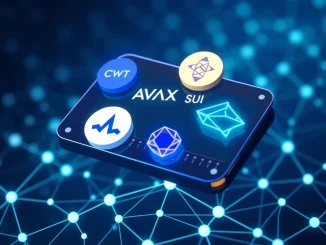
Are you tired of the irreversible nature of cryptocurrency transactions, especially when things go wrong? Imagine a world where you have a safety net for your stablecoin payments, even in the decentralized realm. Well, Circle, the powerhouse behind USDC, just dropped a game-changer: the Refund Protocol. This isn’t just another update; it’s a fundamental shift in how we think about trust and security in crypto payments, especially for everyday users venturing into the non-custodial space.
What is the Circle Refund Protocol and Why Should You Care About Stablecoin Refunds?
Let’s face it, the ‘finality’ of blockchain transactions can be both a blessing and a curse. While it’s great for preventing double-spending, it can be terrifying if you accidentally send stablecoins to the wrong address or get scammed. Traditional stablecoin payments often mimic cash – once it’s gone, it’s gone. But Circle’s Refund Protocol is designed to change this narrative. It’s a smart contract system built to introduce a layer of security and flexibility into stablecoin refunds, particularly within non-custodial wallets and applications. Why is this important? Because as crypto adoption grows, making transactions safer and more user-friendly is paramount. This protocol addresses a critical gap: providing recourse when things go wrong in the world of decentralized finance (DeFi).
Think of it like this:
- Traditional Crypto Payments: Like sending cash – instant, but irreversible and risky if errors occur.
- Circle Refund Protocol: Introduces a system akin to digital checks or escrow for stablecoins, offering potential recourse and dispute resolution.
This is particularly crucial for:
- New Crypto Users: Reduces the fear of making irreversible mistakes when interacting with stablecoins.
- Non-Custodial Wallet Users: Empowers users with more control and security over their funds in decentralized environments.
- Businesses Adopting Crypto: Provides a more robust and trustworthy system for accepting stablecoin payments.
Diving Deeper: How Does This Revolutionary Non-Custodial Refunds System Work?
The magic of the Circle Refund Protocol lies in its smart contract architecture. It introduces several key features that move beyond simple, irreversible transactions:
- Lockups: Transactions can be designed with a time-based lockup period. This means the recipient doesn’t immediately gain full access to the funds. This lockup period can be crucial for various use cases, such as escrow-like services or conditional payments.
- Arbiter-Mediated Refunds: In case of disputes, the protocol allows for the involvement of a designated arbiter. This arbiter, defined within the smart contract, can help resolve disagreements and facilitate non-custodial refunds based on predefined conditions. This is a significant step towards bringing real-world dispute resolution mechanisms into DeFi.
- Early Withdrawals: The protocol also incorporates mechanisms for early withdrawals under certain conditions, adding further flexibility to stablecoin transactions. Imagine a scenario where a service isn’t delivered as promised; early withdrawal could offer a pathway for users to reclaim their funds.
Essentially, the Refund Protocol transforms a simple stablecoin transfer into a more sophisticated, conditional transaction. It’s not about reversing blockchain transactions in the traditional sense, which is technically challenging and goes against the core principles of immutability. Instead, it’s about building a system *around* stablecoin transfers that provides mechanisms for conditional release and dispute resolution, all managed through smart contracts.
Benefits of the Circle Refund Protocol: Why It’s a Game Changer for Crypto Payments
The introduction of the Refund Protocol by Circle brings a wave of potential benefits to the crypto ecosystem:
- Enhanced Trust and Security: By offering a pathway for stablecoin refunds and dispute resolution, the protocol significantly boosts user confidence in crypto payments. This is especially vital for attracting mainstream adoption.
- Increased Flexibility in Transactions: Lockups, arbiter mediation, and early withdrawals introduce a level of flexibility previously absent in standard stablecoin transactions. This opens up new possibilities for complex financial agreements and conditional payments on-chain.
- Reduced Risk for Non-Custodial Wallet Users: Users managing their own keys in non-custodial wallets often bear the full brunt of transaction errors or scams. The protocol offers a safety net, mitigating some of these risks and making DeFi more accessible.
- Streamlined Dispute Resolution: Instead of relying on complex and often inefficient off-chain methods, the Refund Protocol brings dispute resolution on-chain, making it more transparent and potentially faster.
- Wider Adoption of Stablecoins: By addressing a key user concern – the irreversibility of transactions – the protocol can pave the way for broader adoption of stablecoins in everyday commerce and financial applications.
Are There Any Challenges? Potential Hurdles for On-Chain Dispute Resolution
While the Circle Refund Protocol is a significant leap forward, it’s important to acknowledge potential challenges:
- Arbiter Selection and Trust: The effectiveness of the protocol heavily relies on the selection of trustworthy and impartial arbiters. Establishing clear guidelines and reputation systems for arbiters will be crucial.
- Complexity of Smart Contracts: Implementing and managing smart contracts for non-custodial refunds can be complex, potentially requiring specialized expertise for both developers and users. User-friendly interfaces and educational resources will be essential.
- Scalability and Gas Costs: On-chain dispute resolution processes could potentially be computationally intensive and lead to higher gas costs, especially on blockchains with lower throughput. Optimizing smart contract efficiency and exploring layer-2 solutions might be necessary.
- Potential for Abuse: Like any system, there’s a potential for misuse. Malicious actors might attempt to exploit the stablecoin refunds mechanism for fraudulent purposes. Robust security measures and fraud detection mechanisms will be vital.
- Adoption and Integration: The protocol’s success hinges on its widespread adoption by wallets, exchanges, and other crypto platforms. Incentivizing integration and demonstrating clear benefits to these stakeholders will be key.
Real-World Examples: Where Could We See the Refund Protocol in Action?
The applications of the Refund Protocol are vast and span various sectors:
- E-commerce Escrow: Imagine buying goods online with stablecoins. The Refund Protocol could act as an escrow service, holding funds until the goods are delivered and verified, offering buyer protection.
- Freelance Platforms: Freelancers could use the protocol to ensure payment upon completion of tasks. Funds could be locked until the work is approved, providing security for both freelancers and clients.
- Decentralized Marketplaces: On platforms for trading digital assets or NFTs, the protocol could facilitate safer transactions by providing a mechanism for dispute resolution and stablecoin refunds in case of fraudulent listings or unmet obligations.
- Subscription Services: For decentralized subscription services, the protocol could enable conditional payments, allowing users to withdraw funds if the service is interrupted or not delivered as expected.
- DAOs and Governance: DAOs could utilize the protocol for managing funds allocated for specific projects or proposals. Lockups and conditional releases could ensure accountability and prevent misuse of funds.
Actionable Insights: What Does This Mean for You?
For crypto users, the Circle Refund Protocol signals a positive shift towards a more secure and user-friendly DeFi ecosystem. Here’s what you should consider:
- Stay Informed: Keep an eye on developments around the Refund Protocol and its adoption by wallets and platforms you use.
- Explore Non-Custodial Wallets: As the protocol focuses on non-custodial environments, now might be a good time to explore the benefits of self-custody and wallets that integrate this new feature.
- Understand the Mechanics: Familiarize yourself with the concepts of lockups, arbiter mediation, and early withdrawals to fully leverage the potential of the protocol when it becomes widely available.
- Demand Integration: If you are a user of a particular crypto platform or wallet, express your interest in seeing the Refund Protocol integrated to enhance security and flexibility.
Conclusion: A Bold Step Towards Mainstream Crypto Adoption
Circle’s launch of the Refund Protocol is more than just a technical update; it’s a powerful statement about the evolution of stablecoins and the broader crypto space. By addressing the critical issue of transaction irreversibility and introducing mechanisms for stablecoin refunds and on-chain dispute resolution, Circle is taking a bold step towards making crypto safer, more trustworthy, and ultimately, more accessible to everyone. This innovation has the potential to unlock new use cases, foster greater confidence in DeFi, and pave the way for mainstream adoption of stablecoins as a truly viable alternative to traditional payment systems. The future of crypto payments is looking brighter, and protocols like this are leading the charge.



